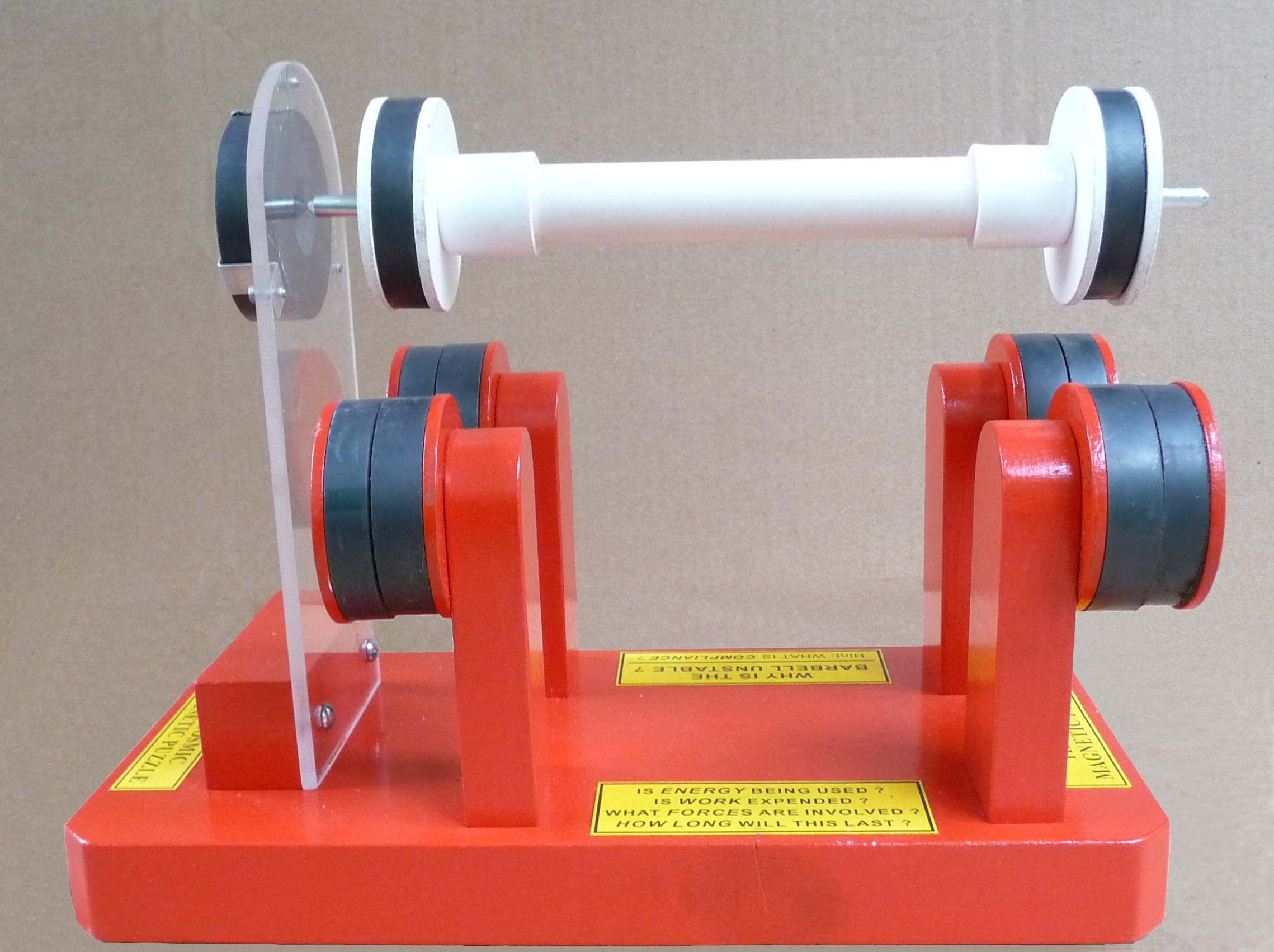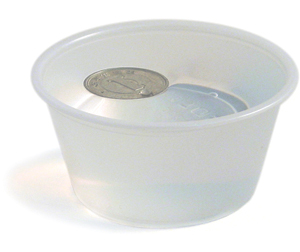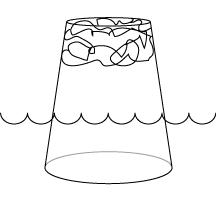March 30, 2010
 by: Cynthia House
by: Cynthia House
I sponsor an after school Science Club in a K-5 elementary school. The club is organized into two-week-long sessions, each session focusing on a specific topic. One of this year’s most successful sessions involved the Archimedes Balance from Educational Innovations.
Archimedes Balance Experiment 1:
- answer sheet, listing the sample materials and their densities
- fill-in table to record findings:
Students worked in pairs with first and second grade children teamed with a fourth or fifth grade student. We introduced the topic with a brief Power Point biography of Archimedes and his accomplishments, focusing on the story of King Hieron’s crown. Then students practiced determining the density of materials using the Archimedes balance and the samples supplied in the sets (all directions are included in the kit).
The Archimedes Balance relies on Archimedes’ principle which states that a floating object displaces its own weight of fluid. The balance consists of a graduated cylinder partially filled with water and a tube that fits inside the cylinder and can float in the water. By placing an object inside the inner tube and measuring the amount of water displaced, you can easily determine the objects weight. Read the rest of this entry »
 Leave a Comment » |
Leave a Comment » |  Chemistry, density, Elementary level, experiments, High School level, Middle School level | Tagged: Archimedes balance, density, King Hieron's crown, mass, science club activities, volume |
Chemistry, density, Elementary level, experiments, High School level, Middle School level | Tagged: Archimedes balance, density, King Hieron's crown, mass, science club activities, volume |  Permalink
Permalink
 Posted by Tami O'Connor
Posted by Tami O'Connor
March 25, 2010
 by: Martin Sagendorf
by: Martin Sagendorf
We often think we see forces. However, in reality, we only see the results of forces. To understand forces we must believe in Newton’s Third Law. It states that all forces can only exist in opposite pairs and be equal in magnitude. And… what is very interesting is that Newton’s Third Law does not stipulate that the forces be of the same kind.
Also, by Newton’s Second Law: If the (net) forces are equal, there will be no accelerations (Fnet = ma = 0)… in other words… equal and opposite (net) forces create a state of equilibrium. An interesting example of equal and opposite (and unlike-type) forces is that exhibited by a combination of opposed magnetic fields within a gravitational (force) field. These two different (types) of fields interact purely as ‘force fields’ – only their forces matter… not their types.
The Cosmic Magnetic Puzzle exemplifies a combination of such forces: a barbell containing two ‘donut’ magnets supported in mid-air above stationary pairs of magnets – with an additional pair of donut magnets maintaining the horizontal location of the barbell.

Read the rest of this entry »
 Leave a Comment » |
Leave a Comment » |  College level, experiments, High School level, magnetism, Middle School level, Physics | Tagged: balanced forces, cosmic magnetic puzzle, force and motion, magnets, Newton's First Law, Newton's Second Law |
College level, experiments, High School level, magnetism, Middle School level, Physics | Tagged: balanced forces, cosmic magnetic puzzle, force and motion, magnets, Newton's First Law, Newton's Second Law |  Permalink
Permalink
 Posted by Tami O'Connor
Posted by Tami O'Connor
March 25, 2010
 by: Martin Sagendorf
by: Martin Sagendorf
Imagine students’ amazement when they actually see sunlight melt a penny with the Atomic Penny Vaporizer! This demonstration clearly illustrates the vast amount of energy illuminating the Earth’s surface. In rough numbers: 70% of the Sun’s incident energy on our outer atmosphere is reflected back into space – only about 30% actually gets to the Earth’s surface. But, as we experience, this is still a substantial quantity of energy.
Fortunately, this energy (I. R. – Visible – U. V.) is rather uniformly distributed over the Earth’s surface – thus its overall intensity is such that we have a habitable environment. However, as we all know, we can concentrate some ‘area’ of this energy to increase the ‘energy per area’ (a measure of this is the temperature of the area of concentrated energy). A common magnifying lens (2-4 in. diameter) will concentrate sufficient energy to burn paper or other objects with a low flash point. Read the rest of this entry »
 2 Comments |
2 Comments |  College level, energy, experiments, High School level, Middle School level, Physics | Tagged: Fresnel lens, how to build physics apparatus, melting zinc, phenomenon based learning, physics demonstration apparatus, STEM, sun's energy, thermal energy, vaporizing pennies |
College level, energy, experiments, High School level, Middle School level, Physics | Tagged: Fresnel lens, how to build physics apparatus, melting zinc, phenomenon based learning, physics demonstration apparatus, STEM, sun's energy, thermal energy, vaporizing pennies |  Permalink
Permalink
 Posted by Tami O'Connor
Posted by Tami O'Connor
February 24, 2010
 by: Ron Perkins
by: Ron Perkins
Who knew that a single coin could be used for so many classroom science activities! You can demonstrate concepts such as surface tension, buoyancy, and even eddy currents with Japanese yen coins!
Surface Tension: Even though aluminum has a density of 2.7 gm/cm3, and the density of water is 1 g/cm3, aluminum yen coins can float on the surface of the water!
Surface tension is a physical property of water. It is caused by cohesion, which is the attraction of like molecules. Water molecules are made up of two hydrogen atoms and one oxygen atom. The “stickiness” of water is caused by hydrogen bonding. This hydrogen bonding pulls the water molecules towards one another and forms a sort of “skin” on the surface of the water.
Japanese Yen Coins Experiment 1:
 Using a bent paper clip or a plastic fork, gently lower the flat side of the coin onto the surface of a pan or cup of water and remove the clip or fork. The coin should rest on the surface of the water. Read the rest of this entry »
Using a bent paper clip or a plastic fork, gently lower the flat side of the coin onto the surface of a pan or cup of water and remove the clip or fork. The coin should rest on the surface of the water. Read the rest of this entry »
 1 Comment |
1 Comment |  Chemistry, Elementary level, experiments, Middle School level | Tagged: buoyancy, density, eddy currents, floating, hydrogen bonding, parent friendly, phenomenon based learning, surface tension, variables, yen |
Chemistry, Elementary level, experiments, Middle School level | Tagged: buoyancy, density, eddy currents, floating, hydrogen bonding, parent friendly, phenomenon based learning, surface tension, variables, yen |  Permalink
Permalink
 Posted by Tami O'Connor
Posted by Tami O'Connor
February 12, 2010
 by: Tami O’Connor
by: Tami O’Connor
The W-Tube is a device that was invented and developed by Ron Perkins, Chemistry and Physics high school teacher for 33 years and founder of Educational Innovations. This amazing teaching tool was designed to have students in every grade level, kindergarten through high school, discover and gain a deeper understanding of concepts relating to density and air pressure.
In order to solve each puzzle, students need to have a basic understanding of density and air pressure. Depending upon the grade level of your students, you may want to conduct a few experiments or demonstrations prior to having them attempt the W-Tube challenges on their own. The following two activities do not utilize the W-Tube, however they will provide some younger students with the background knowledge necessary to successfully complete the W-Tube challenges.
This first activity is a valuable demonstration that shows that air takes up space. Start by balling up a paper towel or tissue and affixing it to the bottom of a plastic cup using two-sided tape. Invert the cup with the tissue inside and then  push the plastic cup into a clear container of water so the cup is completely submerged. Your students should be able to see that, although the air is somewhat compressed within the cup, the paper at the “top” of the cup remains dry. Read the rest of this entry »
push the plastic cup into a clear container of water so the cup is completely submerged. Your students should be able to see that, although the air is somewhat compressed within the cup, the paper at the “top” of the cup remains dry. Read the rest of this entry »
 Leave a Comment » |
Leave a Comment » |  Chemistry, density, Elementary level, experiments, High School level, Middle School level, Physics | Tagged: air pressure, density, science challenges, W-Tube |
Chemistry, density, Elementary level, experiments, High School level, Middle School level, Physics | Tagged: air pressure, density, science challenges, W-Tube |  Permalink
Permalink
 Posted by Tami O'Connor
Posted by Tami O'Connor
 by: Cynthia House
by: Cynthia House


 Posted by Tami O'Connor
Posted by Tami O'Connor  by: Martin Sagendorf
by: Martin Sagendorf


 by: Tami O’Connor
by: Tami O’Connor push the plastic cup into a clear container of water so the cup is completely submerged. Your students should be able to see that, although the air is somewhat compressed within the cup, the paper at the “top” of the cup remains dry.
push the plastic cup into a clear container of water so the cup is completely submerged. Your students should be able to see that, although the air is somewhat compressed within the cup, the paper at the “top” of the cup remains dry.